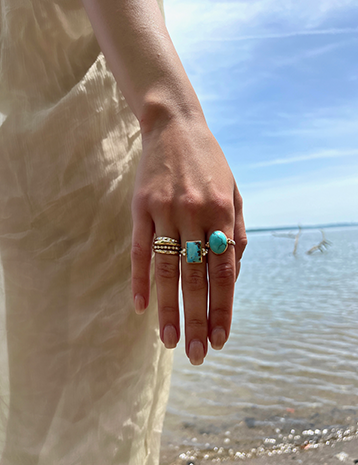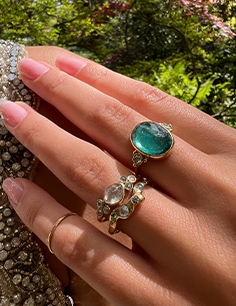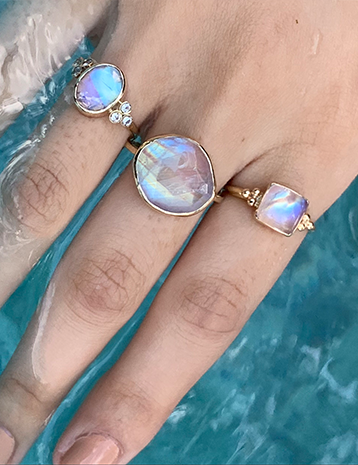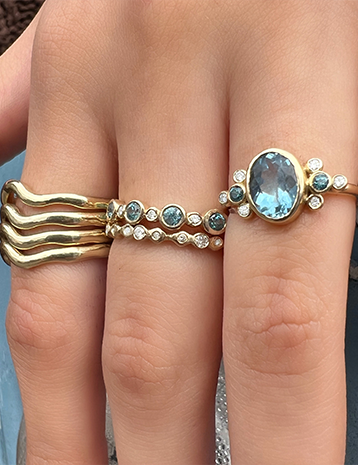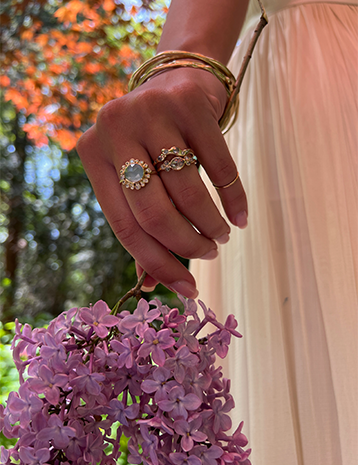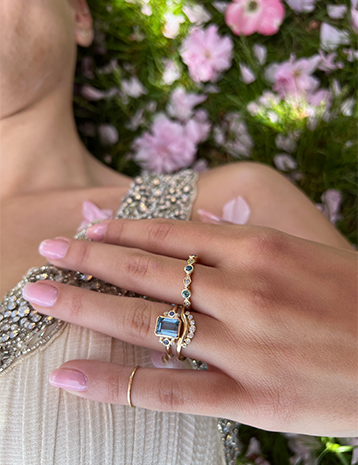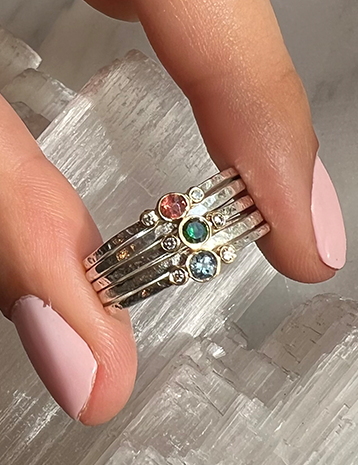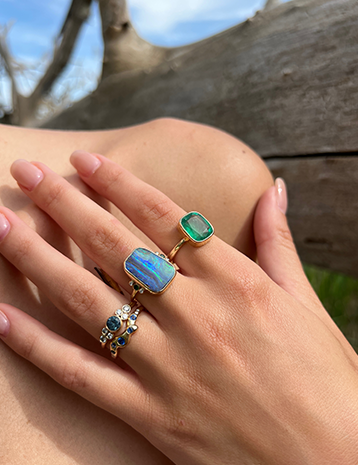
The flashy birthstone of October is one of Emily’s favorite gems, the most prized of which hail from the mines in Australia. Opals are formed when water flows deep within crevices in rock and petrified wood; along the way it picks up silica from sandstone deposits and when the water evaporates you are left with an opal. It sounds simple but it typically takes about 5 million years for 1 centimeter of opal to form, which is why natural opals are so incredibly valued. Opal hardness is dependent on its exact composition and formation conditions but ranges from 5 to 6.5 on the Mohs scale. Its toughness is fair, making opal a gem that is suitable for jewelry but requires care when wearing so as to not scratch or break the stone. Emily has an unparalleled eye for choosing the most spectacularly prismatic opals from Australia, Indonesia, Peru and beyond. She is particularly drawn to those stones with unique patterns in the coloring like striping and checkerboard patterns.

Tourmaline is one of our most beloved stones because of its wide variety of shades and unique color combinations. From Watermelon to Deep fuschia, peach to vibrant teal, tourmalines come in every color of the rainbow. Gaining notoriety and value and hailing from the copper rich mines in Brazil, Paraiba Tourmalines were discovered in 1989 and today can fetch a ct price that exceeds that of diamonds. Paraibas are only able to be hand mined and formed in thin pencil like structures making extracting them a timely and expensive process. Their neon teal glow seems otherworldly so it's easy to see why they have become one of the most coveted stones in the world. The largest deposits of the world's Tourmalines are found in Brazil, however this rainbow stone can be found in Nigeria, Mozambique, Kenya, Tanzania and The US. Tourmaline ranks 7 - 7.5 on the Mohs hardness scale which is considered fairly hard and because of its wide color range (it comes in more colors and combinations than any other gemstone) therefore makes great options for alternative engagement rings. October babies (Emily’s son included) get to call this gemstone, along with opals, their own.

Rainbow Moonstones fall under the feldspar mineral group and rate between 6 - 6.5 on Mohs hardness scale which makes them good for jewelry. The enchantment of a moonstone is when light falls between its thin layers, scattering in many directions, producing the phenomenon called adularescence. Adularescence is the light that appears to ripple across a gemstone, giving its surface a glowing appearance. Moonstones display a much softer glow in comparison to the rainbow moonstones which typically have brighter blue flashes in them. Moonstones are often used as an alternative to pearl and alexandrite as a birthstone for June. Most of our Rainbow Moonstones are found in India, where they are known as “dream stones” and worn at night to facilitate wonderful dreams. Emily has a keen eye for choosing the most exquisite Rainbow Moonstones with the most prismatic flash. While Moonstone and Rainbow Moonstone are related there is a bit of difference to the gems. Moonstone is Orthoclase Feldspar (derived from calcium sodium) while Rainbow Moonstone is a Plagioclase Feldspar (derived from potassium sodium), which is the same chemical composition for Labradorite. Rainbow Moonstone can often contain Black Tourmaline inclusions and despite the name a Rainbow Moonstone is in fact a White Labradorite.

Morganite
Morganites have recently captured the hearts of those who are the “forever romantics”. This blush pink to peach gemstone is becoming increasingly popular as an alternative engagement ring being associated with the heart chakra and “unconditional love”. Morganite is part of the beryl mineral family (which makes it a “sister” to the well loved Aquamarines and Emeralds). However, unlike emeralds, which tend to have a lot of inclusions, morganite gemstones are relatively free of inclusions, making them more eye-appealing and easier to care for. Ranking in the range of 7.5 - 8 on Mohs hardness scale it lends itself to be an ideal piece to be worn and enjoyed daily.
Dendritic Agate
Agate is an ornamental variety of Chalcedony. While standard cuts of Agate are readily available and easy to find, Dendritic Agate is a sought-after rarity! Dendrites are fern-like inclusions of iron or other metallic oxides that create unique patterns in each stone. The word is derived from a Greek word meaning “tree-like”. It is known as the stone of Plentitude and brings the wearer abundance in all aspects of life. For Emily Amey jewelry, we choose the most unique Dendritic agates from Northern India.

Sapphires have been highly prized and desired for centuries and our obsession with them as a species goes as far back as 800 BC. Their excellent color arrangement, hardness, durability, and luster lend them to be excellent stones for jewelry and alternative engagement rings. They score a 9 on Mohs hardness scale just after diamonds. Sapphires are available in almost all the colors of the rainbow except for the vibrant red which would be classified as a ruby instead. Perhaps the most rare and increasingly more popular is the Padparascha sapphire. It features a combination of two hues in a single stone (pink and orange) creating an enticing peachy hue. While this gemstone is designated for the September birthstone, it’s safe to say it is extremely sought after and loved by many. Another variety, the Star Sapphire, occurs when the stone exhibits an asterism inclusion that allows the appearance of a star shaped pattern within the stone. Emily has a deep admiration (and obsession with) the intense Orange Sapphires.

Aquamarine
Aquamarine is Latin for “Water of the Sea” which is easy to see why when looking at its oceanic blue coloring. Aquamarine is in the beryl family; along with Emerald, Morganite, and Heliodor, and gets its blue-green coloring from the iron deposits in the crystal. Scoring a 7.5 - 8 on the Mohs hardness scales makes aquamarines suitable for those with active lifestyles who may be a little harder on their jewelry than others and is the enviable birthstone of March babies. We love its calming energy and ability to increase tolerance and communication. Emily has a deep love for picking the most desirable Aquamarines and it is one of our most coveted stones, with many of our pieces featuring it selling mere hours after we complete them.

Ruby
Associated with bringing the wearer health and wealth, rubies are the birthstone of July and known for their blood red coloring. Rubies are a variety of the mineral corundum which comes in an assortment of other colors, but those are classified as sapphires. Ruby measures 9 on the Mohs Scale of Hardness, second only to diamond and matched with sapphires. This lends them to be excellent gemstones for jewelry and alternative engagement rings. The most prized Rubies are from Burma, but rubies are mined all over the world including Afghanistan, Australia, Cambodia, India, Mozambique, Pakistan, Sri Lanka, the United States. Like their sister stone sapphires, Star Rubies occur when the needles formed deep within the stone can cause the star effect, known as asterism, most visible when the stone is cut into a cabochon. Rubies are a fiery staple of the gemstone world; and have been at the forefront of luxury and lore for centuries.
Turquoise
Discovery of beads made from turquoise dates back to 3000 BCE making this gemstone one of the first to be used in jewelry and other wearable art. Turquoise is an opaque stone that is formed from a chemical reaction occurring when water containing minerals like copper and aluminum are trapped within rock. It can be found in a variety of colors with most valued being the vibrant blue-green similar in coloring to robin’s egg blue, and can be matrixed with other materials like Pyrite and Copper. Turquoise ranks 5 to 6 on the Mohs scale and its toughness is generally fair to good. Being that we have examples of Turquoise jewelry from over 5000 years ago is a great indication of the longevity and durability of the stone. In America the most prized Turquoise hails from Arizona and Nevada; across the globe, Kazakhstan, Chinese and Persian turquoise are at the top of the list. At Emily Amey, we have fostered close relationships with Turquoise dealers that work with ethically mined stones from Bisbee, Kingman, Damele, Persian, Number 8, Red Tunnel, Royston, Cloud Mountain, Sleeping Beauty and many other incredible mines. When picking the perfect Turquoise it's hard to pinpoint an ideal specimen since the stone encompasses so many unique traits, which is why we love it so much, there is a turquoise for everyone.
.



